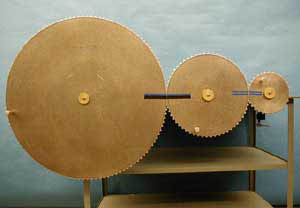Demos: 1Q-07 Tangent Circles

Three wheels having diameters 30”, 15” and 7.5”, respectively, are connected tangentially by means of gear teeth. When one of the wheels is rotated, the other wheels rotate in alternating opposite directions and the ratio of the number of revolutions is shown to be the the ratio of the diameters.
Directions: Start with the wheels lined up in such a way that the tape marks are aligned. By rotating, say, the 7.5” diameter wheel, you can show that when the tape on that wheel returns to its initial position, the tape on the next wheel will have gone through 1/2 revolution and the tape on the third wheel will have gone through 1/4 revolution. (The gear mechanism insures that there is no slippage.)
Suggestions for Presentation: Point out that the rims of each of the wheels are interconnected. What does this tell you about the tangential speeds of the three rims? (They are the same, because there is no slippage.) What role do the different diameters play? Ask the students to predict the rotation rate for each wheel relative to the others.
NOTE: One could focus on the gears and discuss the gear ratios in terms of the number of teeth on each wheel. However, the intent here was not to produce a gear demonstration, but to insure that the wheels do not slip relative to each other. The teeth are beveled in such a way that the rims are in firm contact with each other.
Applications: Various gear and pulley systems. For example, if belts are used on pulleys, the tangential speeds are the same, but the rotation rates depend on the diameters.
Last Updated: Nov 30, 2023 11:25 AM